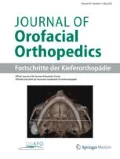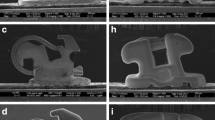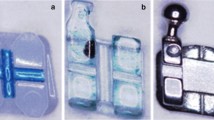Abstract
Aims
The aim of this study was to compare force loss due to friction (Fr) during simulated canine retraction using different archwire dimensions and materials between conventional and new self-ligating brackets.
Methods
The tested brackets were (1) conventional brackets (Victory series, GAC twin and FLI twin), (2) self-ligating brackets (Damon-Q, FLI-SL, new/improved FLI-SL (I FLI-SL), SPEED, GAC innovation (R) and Ortho Classic) and (3) a low-friction bracket (Synergy). All brackets had a 0.022″ slot size. The tested archwires were stainless steel (0.018″; 0.016″x0.022″; 0.017″x0.025″; 0.018″x0.025″ and 0.019″x0.025″); nickel titanium (NiTi; 0.016″x0.022″; 0.017″x0.025″; 0.018″x0.025″ and 0.019″x0.025″) and titanium molybdenum alloy (TMA; 0.016″x0.022″; 0.017″x0.025″; 0.018″x0.025″ and 0.019″x0.025″). Canine retraction was experimentally simulated in a biomechanical set-up using a NiTi coil spring that delivered a force of 1 N. The simulated retraction path was up to 4 mm. Force loss due to friction was compared between groups using the Welch t‑test.
Results
Force loss due to friction increased with increasing archwire size. Also, TMA showed the highest and stainless steel the lowest force loss due to friction. FLI-SL brackets showed the lowest Fr (31%) and Ortho Classic showed the highest (67%).
Conclusions
Increasing wire size generally showed increasing force loss due to friction. FLI-SL brackets showed the lowest, while Ortho Classic showed the highest friction.
Zusammenfassung
Ziele
Ziel der vorliegenden Studie war der Vergleich des Kraftverlustes durch Friktion (Fr) im Zuge der simulierten Eckzahnretraktion. Dabei kamen unterschiedliche Bogendimensionen und -materialien sowie konventionelle und selbstligierende Brackets zum Einsatz.
Methode
Die getesteten Brackets waren (1) konventionelle Brackets (Victory series, GAC twin nd FLI twin), (2) selbstligierende Brackets (Damon-Q, FLI-SL, new/improved FLI-SL (I FLI-SL), SPEED, GAC innovation (R) und Ortho Classic) und (3) ein Low-Friction-Bracket (Synergy). Alle Brackets hatten einen 0.022″ Slot. Die getesteten Bögen waren aus Stahl (0.018″; 0.016″x0.022″; 0.017″x0.025″; 0.018″x0.025″ und 0.019″x0.025″); Nickel-Titan (NiTi; 0.016″x0.022″; 0.017″x0.025″; 0.018″x0.025″ und 0.019″x0.025″) und Titan-Molybdän (TMA; 0.016″x0.022″; 0.017″x0.025″; 0.018″x0.025″ und 0.019″x0.025″). Die Eckzahnretraktion wurde experimentell in einem biomechanischen Versuchsaufbau unter Verwendung einer NiTi-Feder, die eine Kraft von 1 N generierte, simuliert. Der simulierte Retraktionsweg betrug bis zu 4 mm. Der Kraftverlust durch Friktion wurde zwischen den Gruppen mit dem Welch-t-Test verglichen.
Ergebnisse
Kraftverluste durch Friktion nahmen mit steigendem Bogendurchmesser zu. TMA zeigte den höchsten und Stahl den niedrigsten Kraftverlust. FLI-SL Brackets wiesen den niedrigsten Reibungsverlust (31%) und Ortho Classic den höchsten Wert auf (67%).
Schlussfolgerungen
Generell waren zunehmende Bogendimensionen mit zunehmendem Kraftverlust infolge Friktion verknüpft. FLI-SL Brackets wiesen die niedrigste, Ortho Classic die höchste Friktion auf.









Similar content being viewed by others
References
Alobeid A, El-Bialy T, Khawatmi S, Dirk C, Jäger A, Bourauel C (2017) Comparison of the force levels among labial and lingual self-ligating and conventional brackets in simulated misaligned teeth. Eur J Orthod 39:419–425
Andreasen GF, Quevedo FR (1970) Evaluation of friction forces in the 0.022 x 0.028 edgewise bracket in vitro. J Biomech 3:151–156
Articolo L, Kusy R (1999) Influence of angulation on the resistance of sliding in fixed appliances. Am J Orthod Dentofacial Orthop 115:39–51
Bednar JR, Gruendeman GW, Sandrik JL (1991) A comparative study of frictional forces between orthodontic brackets and arch wires. Am J Orthod Dentofacial Orthop 100:513–522
Berger LJ (1990) The influence of the SPEED bracket’s self-ligating design on force levels in tooth movement: A comparative in vitro study. Am J Orthod Dentofacial Orthop 97:219–228
Bourauel C, Drescher D, Thier M (1990) Kraft-Momenten-Aufnehmer für die Kieferorthopädie. Feinwerktech Messtech 98:419–422
Bourauel C, Drescher D, Thier M (1992) An experimental apparatus for the simulation of three-dimensional movements in orthodontics. J Biomed Eng 14:371–378
Braun S, Bluestein M, Moore K, Benson G (1999) Friction in perspective. Am J Orthod Dentofacial Orthop 115:619–627
Burrow SJ (2009) Friction and resistance to sliding in orthodontics: A critical review. Am J Orthod Dentofacial Orthop 135:442–447
Cacciafesta V, Sfondrini MF, Ricciardi A, Scribante A, Klersy C, Auricchio F (2003) Evaluation of friction of stainless steel and esthetic self-ligating brackets in various bracket-archwire combinations. Am J Orthod Dentofacial Orthop 124:395–402
Dholakia KD (2012) Friction and anchorage loading revisited. Orthodontics (Chic) 13:200–209
Drescher D, Bourauel C, Schumacher HA (1990) The loss of force by friction in arch-guided tooth movement. Fortschr Kieferorthop 51:99–105
Drescher D, Bourauel C, Thier M (1991) Application of the orthodontic measurement and simulation system (OMSS) in orthodontics. Eur J Orthod 13:169–178
Ehsani S, Mandich M, El-Bialy TH, Flores-Mir C (2009) Frictional resistance in self-ligating orthodontic brackets and conventionally ligated brackets: A systematic review. Angle Orthod 79:592–601
Feynman RP, Leighton RB, Sands M (2010) Mainly mechanics, radiation, and heat. Feynman lectures on physics. The new millenium edition, vol 1. Perseus Books, Philadelphia, pp 12-3–12-6
Griffiths HS, Sherriff M, Ireland AJ (2005) Resistance to sliding with 3 types of elastomeric modules. Am J Orthod Dentofacial Orthop 127:670–675
Hain M, Dhopatkar A, Rock P (2006) A comparison of different ligation methods on friction. Am J Orthod Dentofacial Orthop 130:666–670
Halazonetis DJ (2007) Friction might increase anchorage loading. Am J Orthod Dentofacial Orthop 131:699–700
Henriques JFC, Higa RH, Semenara NT, Janson G, Fernandes TMF, Sathler R (2017) Evaluation of deflection forces of orthodontic wires with different ligation types. Braz Oral Res 31:e49
Husmann P, Bourauel C, Wessinger M, Jäger A (2002) The frictional behavior of coated guiding archwires. J Orofac Orthop 63:199–211
Jost-Brinkmann P, Miethke RR (1991) The effect of physiological tooth mobility on the friction between the bracket and the arch. Fortschr Kieferorthop 52:102–109
Kim TK, Kim KD, Baek SH (2008) Comparison of frictional forces during the initial leveling stage in various combinations of self-ligating brackets and archwires with a custom-designed typodont system. Am J Orthod Dentofacial Orthop 133(187):e15–e24
Kusy RP, Whitley JQ (1990) Effects of surface roughness on the coefficients of friction in model orthodontic systems. J Biomech 23:913–925
Kusy RP, Whitley JQ (1997) Friction between different wire-bracket configurations and materials. Semin Orthod 3:166–177
Kusy RP, Whitley JQ (1999) Influence of archwire and bracket dimensions on sliding mechanics: Derivations and determinations of the critical contact angles for binding. Eur J Orthod 21:199–208
Kusy RP (2000) Ongoing innovations in biomechanics and materials for the new millennium. Angle Orthod 70:366–376
Loftus B, Årtun J, Nichollis J, Alonzo T, Stoner J (1999) Evaluation of friction during sliding tooth movement in various bracket-arch wire combinations. Am J Orthod Dentofacial Orthop 116:336–345
Montasser MA, El-Bialy T, Keilig L, Reimann S, Jäger A, Bourauel C (2014) Force loss in archwire-guided tooth movement of conventional and self-ligating brackets. Eur J Orthod 36:31–38
O’Reilly D, Dowling PA, Lagerström L, Swartz ML (1999) An ex vivo investigation into the effect of bracket displacement on the resistance to sliding. Br J Orthod 26:219–227
Phukaoluan A, Khantachawana A, Kaewtatip P, Dechkunakorn S, Anuwongnukroh N, Santiwong P, Kajornchaiyakul J (2017) Comparison of friction forces between stainless orthodontic steel brackets and TiNi wires in wet and dry conditions. Int Orthod 15:13–24
Proffit WR, Fields HW, Ackerman J, Bailey L, Tulloch J (2000) Biomechanics and mechanics. In: Proffit WR, Fields HW (eds) Contemporary orthodontics, 3rd edn. Mosby, St Louis, pp 346–347
Rabiee SM, Eftekhari SZ, Arash V, Amozegar N, Fathi A, Tavanafar S, Bijani A (2017) Effect of CO2 laser power intensity on the surface morphology and friction behavior of alumina ceramic brackets. Microsc Res Tech 80:923–929
Reicheneder CA, Baumert U, Gedrange T, Proff P, Faltermeier A, Muessig D (2007) Frictional properties of aesthetic brackets. Eur J Orthod 29:359–365
Riley JL, Garrett SG, Moon PC (1979) Frictional forces of ligated plastic and metal edgewise brackets [Master’s thesis]. Virginia Commonwealth University, Medical College of Virginia, Richmond, Virginia
Savoldi F, Visconti L, Dalessandri D, Bonetti S, Tsoi JKH, Matinlinna JP, Paganelli C (2017) In vitro evaluation of the influence of velocity on sliding resistance of stainless steel arch wires in a self-ligating orthodontic bracket. Orthod Craniofac Res 20:119–125
Schumacher HA, Bourauel C, Drescher D (1990) The effect of the ligature on the friction between bracket and arch. Fortschr Kieferorthop 51:106–116
Shivapuja PK, Berger JA (1994) A comparative study of conventional ligation and self-ligation bracket systems. Am J Orthod Dentofacial Orthop 106:472–480
Southard TE, Marshall SD, Grosland NM (2007) Friction does not increase anchorage loading. Am J Orthod Dentofacial Orthop 31:412–414
Sridharan K, Sandbhor S, Rajasekaran UB, Sam G, Ramees MM, Abraham EA (2017) An in vitro evaluation of friction characteristics of conventional stainless steel and self-ligating stainless steel brackets with different dimensions of archwires in various bracket-archwire combination. J Contemp Dent Pract 18:660–664
Wichelhaus A, Geserick M, Hibst R, Sander FG (2005) The effect of surface treatment and clinical use on friction in NiTi orthodontic wires. Dent Mater 21:938–945
Taylor N, Ison K (1996) Frictional resistance between orthodontic brackets and archwires in the buccal segments. Angle Orthod 66:215–221
Tecco S, Di Iorio D, Cordasco G, Verrocchi I, Festa F (2007) An in vitro investigation of the influence of self-ligating brackets, low friction ligatures, and archwire on frictional resistance. Eur J Orthod 29:390–397
Thorstenson GA, Kusy RP (2002) Comparison of resistance to sliding between different self-ligating brackets with second order angulation in the dry and saliva states. Am J Orthod Dentofacial Orthop 121:472–482
Tidy D (1989) Frictional forces in fixed appliances. Am J Orthod Dentofacial Orthop 96:249–254
Whitley JQ, Kusy RP (2007) Influence of interbracket distances on the resistance to sliding of orthodontic appliances. Am J Orthod Dentofacial Orthop 132:360–372
Yamaguchi K, Nanda RS, Morimoto N, Oda Y (1996) A study of force application, amount of retarding force, and bracket width in sliding mechanics. Am J Orthod Dentofacial Orthop 109:50–56
Yeh CL, Kusnoto B, Viana G, Evans CA, Drummond JL (2007) In-vitro evaluation of frictional resistance between brackets with passive-ligation designs. Am J Orthod Dentofacial Orthop 131(704):e11–e22
Acknowledgements
This study was supported by Alexander von Humboldt Foundation, Germany.
Author information
Authors and Affiliations
Corresponding author
Ethics declarations
Conflict of interest
T. El-Bialy, A. Alobeid, C. Dirk, A. Jäger, L. Keilig and C. Bourauel declare that they have no competing interests.
Ethical standards
This article does not contain any studies with human participants or animals performed by any of the authors.
Rights and permissions
About this article
Cite this article
El-Bialy, T., Alobeid, A., Dirk, C. et al. Comparison of force loss due to friction of different wire sizes and materials in conventional and new self-ligating orthodontic brackets during simulated canine retraction. J Orofac Orthop 80, 68–78 (2019). https://doi.org/10.1007/s00056-019-00168-8
Received:
Accepted:
Published:
Issue Date:
DOI: https://doi.org/10.1007/s00056-019-00168-8




